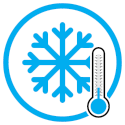SMDHU: Cold Warning and Information System (CWIS)
 The Simcoe Muskoka District Health Unit (SMDHU) monitors forecasts from December 1st to March 31st. SMDHU follows two cold notification processes. Cold Warning Alerts (-15ºC Enhanced Cold Notifications and Extreme Cold Warnings) are issued when temperatures are forecasted to reach cold warning criteria.
The Simcoe Muskoka District Health Unit (SMDHU) monitors forecasts from December 1st to March 31st. SMDHU follows two cold notification processes. Cold Warning Alerts (-15ºC Enhanced Cold Notifications and Extreme Cold Warnings) are issued when temperatures are forecasted to reach cold warning criteria.
There are currently no cold notifications or warnings issued for Simcoe Muskoka. It is important to remember that even mild cold temperatures can affect health. Always take steps to stay dry and warm during the winter months.
Cold weather is common in the Simcoe Muskoka region. Exposure to cold weather and extreme cold can cause serious and sometimes life-threatening health problems and injuries but these can be prevented. You can protect yourself and those you care about by being aware of how cold weather affects your health and taking steps to reduce your risk. Extreme cold warnings are issued by Environment and Climate Change Canada when temperatures or wind chills fall below thresholds for at least two hours within a 24-hour period. These thresholds are -30ºC for Simcoe County and -35ºC for the District of Muskoka.
Who is at risk?
Extreme cold can affect everyone's health but some people are at a higher risk. Factors like weather, housing conditions, age, overall health, activities, and access to resources all play a role. Those who may be more at risk include:
- Infants and children
- Older adults
- People with certain medical conditions and/or taking certain medications (e.g., beta-blockers)
- People who don't have adequate shelter, are experiencing homelessness, or are living in homes that are poorly insulated or have no heat/power
- Newcomers to Canada
- People who spend long periods of time outdoors for work or leisure
How cold affects your health:
Cold temperatures can make respiratory illnesses such as asthma, chronic bronchitis, and emphysema worse and increase the risk of heart attacks and strokes. The worsening of these health conditions can occur up to several days after being exposed to cold temperatures. If you have an existing heart or lung condition, speak with your healthcare provider about ways to protect your health during cold temperatures.
Immediately call 911 if you think you or someone else is, or could be, having a heart attack, stroke, or experiencing another medical emergency.
Being in the cold can cause hypothermia, frostbite, and frostnip. Hypothermia happens when the body loses heat faster than it can make it and is a serious medical issue. Frostnip and frostbite are cold-weather skin injuries caused by exposure to freezing temperatures and wind. Frostnip happens first and can turn into frostbite if not treated. If you think you or someone has hypothermia or frostbite, seek immediate medical attention.
How to protect yourself:
You can protect yourself and those you care about from the cold by following these steps:
- Check the local weather reports and be aware of the weather conditions before going outside.
- Watch for signs of frostnip, frostbite, and hypothermia when in the cold.
- Consider staying indoors when temperatures are below -27ºC (with or without wind chill).
- Dress warmly and cover exposed skin by wearing a hat, gloves/mittens, and a neck warmer or scarf. Wear warm socks and waterproof boots, if you are able. If your clothes get wet, change into dry clothes as soon as possible.
- Dress in layers that include an inner layer of clothing that has 'wicking' properties to remove moisture (sweat) from the skin; a middle layer such as a sweater to keep you warm, and a wind-resistant top layer.
- Wear sunglasses, lip balm, and sunscreen to protect your skin from ultraviolet radiation (UV rays) causing sunburns, and skin and eye damage. See Health Canada's sun protection through the seasons for more information.
- Wear a face mask and goggles if you are participating in winter activities such as skiing, snowmobiling, and skating to protect your face from frostbite and windburn. Be sure to frequently check in with children and ensure they remain properly dressed.
- Keep moving to keep your blood flowing and limit time spent standing or sitting.
- Drink warm fluids (e.g., non-caffeinated tea, water, milk) to warm up or stay warm. Avoid caffeinated or alcoholic beverages as they can cause your body to lose heat more quickly.
- Take shelter from the wind to reduce wind chill exposure and if possible, take regular breaks in a heated building.
- Check in on neighbours, friends, and family during extreme cold.
Warming spaces are available throughout Simcoe Muskoka to provide relief from the cold. They are usually found in municipal buildings, libraries, and community centres and open to the public during regular business hours.
To find an open warming centre near you, visit the County of Simcoe and District of Muskoka's websites.